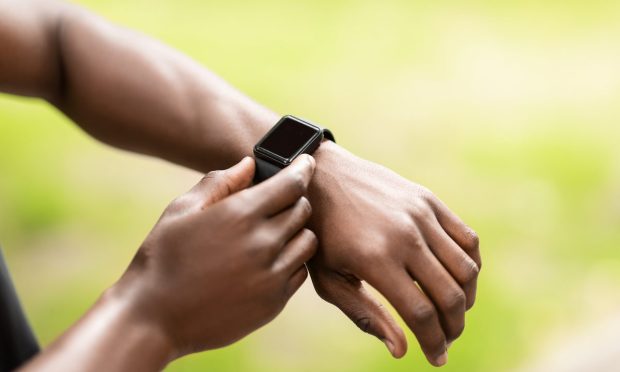Health Monitoring Puts the ‘H’ in Smartwatch as Wearables Boost Their Utility

Samsung fired its latest shot across the bow of wearables category leader Apple on Aug. 26 with the launch of its Samsung Galaxy Watch 4. Are the wearables wars heating up again?
Noting, “It’s not your typical Wear OS watch … it’s called One UI Watch 3, and it’s been built by Samsung with Google’s help,” TechRadar reported that the upgrade “is limited, but the Watch 4 is suitable for anyone who’s looking for a top-end smartwatch that can track workouts, as well as offer a lot of other smart features that many alternative wrist companions can’t.”
When someone says “alternative wrist companions,” odds are they mean Apple, a company not known for letting others eat its lunch. Perhaps for that reason, revelations that The House That Jobs Built is working on a next-gen smartwatch are more expectation than exclamation by now.
The Wall Street Journal reported on Wednesday (Sept. 1) that “Apple Inc. is working on new health-related features for its smartwatch, including a tool to tell users when their blood pressure is increasing and a thermometer to help with fertility planning, according to people familiar with the plans and internal company documents.”
Major players are putting big money and planning behind wearables for healthier living, expanding on the workout widgets that arguably attract the most consumer attention.
Witness wearables firm Whoop raised $200 million more in an August Series F funding round that puts the Boston-based startup’s valuation to $3.6 billion.
Read more: Wearables Startup Whoop Notches $200M At $3.6B Valuation
As PYMNTS reported, “Whoop offers a digital coach to help people meet health and fitness goals. The program is available every day of the year, 24 hours a day and is being used by professional athletes like Kansas City Chiefs quarterback and two-time NFL Super Bowl champ Patrick Mahomes and NBA Los Angeles Lakers MVP LeBron James, among others. The wearable is also the official wearable of the NFL Players Association, according to the Whoop website.”
Who Wore It Best?
Wearables have struggled somewhat over the years. Google famously launched its first-generation Google Glass in 2013, only to pull it from the market in 2015. In 2017 the company returned with its Glass Enterprise Edition for commercial use, now in its second iteration.
Google also prevailed late last year in its bid to acquire fitness wearable Fitbit, with PYMNTS reporting in December that “The acquisition was the focus of controversy initially, as critics worried that the tech giant could use customer data for its own purposes and that it could further consolidate the power Google had in the tech world.”
Learn more: Google Approved By EU To Acquire Fitbit
For all its perseverance, however, Google is still a distant second to category killer Apple. The company pulled ahead early on, using Apple’s considerable cool factor to do the selling. As sales spiked then fell, the Silicon Valley powerhouse doubled down where the action is: health.
Per recent Wall Street Journal coverage, “Apple is planning for the watch to take a person’s temperature by next year, according to the documents and people familiar with the feature,” adding, “A planned use for the sensor in 2022 would be for fertility planning, the people said, giving women clues about where they are in their ovulation cycle. Already this is available from startups, including Natural Cycles USA Corp., whose birth-control app was cleared by the Food and Drug Administration in 2018.” WSJ said Apple is seeking FDA approval for wearables.
Wearable Payments are a Good Look
This year is seen by many as a possible breakout time for wearables, with pandemic fears driving adoption of all touchless tech, and these devices becoming more utilitarian all the time.
In April PYMNTS reported that Munich-based Smart Payments Association (SPA) “updated its original guidance, noting in its position paper Wearable Tech 2021: The Future Is Now that ‘… wearable payment volumes will have reached $501.1 billion by the end of 2020, accounting for 20% of all proximity payments,’ and that ‘wearable payments increased by 365% between 2017 and 2020, with a quarter of Europeans planning to buy goods and services using the technology in the future.’”
Read also: Smart Payments Association Says 2021 Is Pivotal Year For Wearable Payments Tech
Estimates of market size vary, with Grand View Research predicting earlier this year that “global wearable payments devices market size is expected to reach USD 80.39 billion by 2028 … [and] is expected to expand at a CAGR of 29.8% from 2021 to 2028.”
Predictions are just that. These folks aren’t fortune tellers. But they could become mind readers if they select a certain wearable that has brainy ambitions.
As PYMNTS reported in Q1 2021, “Facebook previewed its latest and greatest technology advances — in this case, a wearable that can read a user’s mind and give them superpowers, liking typing on a keyboard even when there is no keyboard there. The prototype device out of Facebook Reality Labs revealed to the media … is reportedly capable of reading neurological signals sent from a users’ brain down to their hands. The device will theoretically be able to use signals to determine the user’s intent, either in a real or augmented reality (AR) environment.”
Related: Coming Soon To A Wrist Near You: Wearables That Can Read Your Mind
